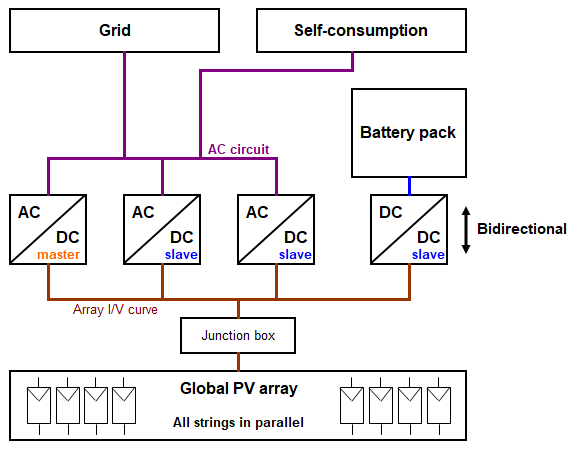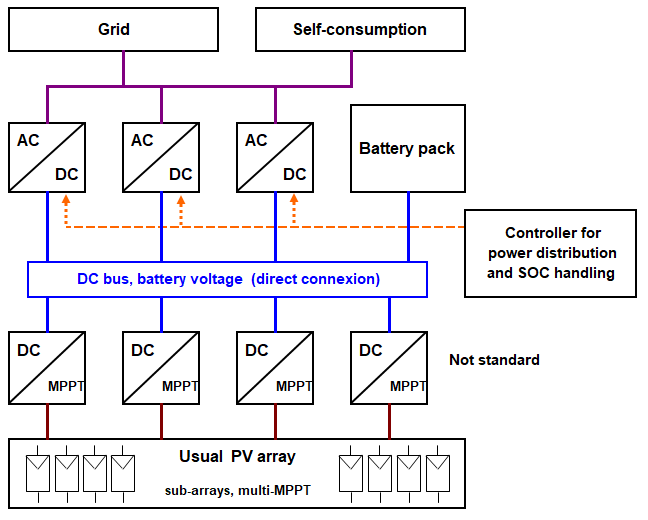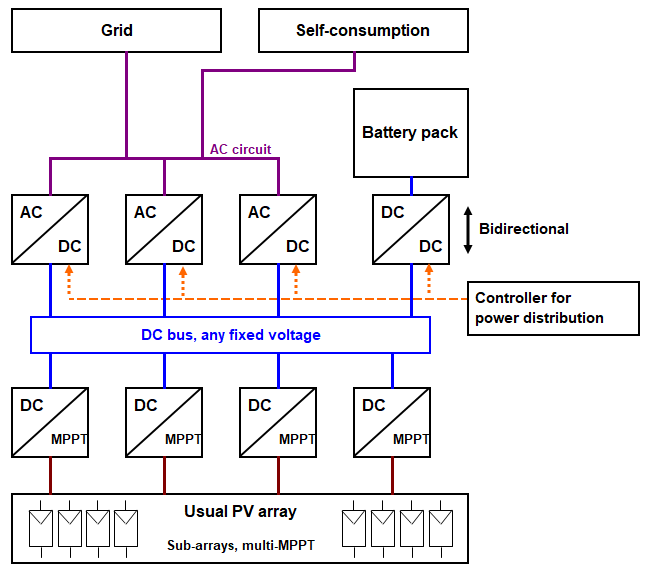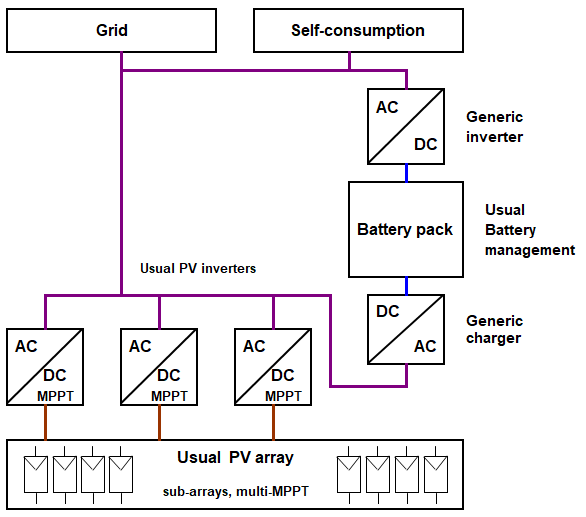See also Grid systems with storage for generalities.
PVsyst architecture
In PVsyst, for all strategies the PV system is defined as a standard grid-connected system, with usual solar inverters.
The battery pack is unique (centralized). The charging is ensured by an AC-DC charger, connected on a common AC bus at the inverters output. The delivery of the stored energy is done by a DC-AC inverter, either to the grid and to the possible self-consumption.
The DC-AC inverter is quite different than the usual PV inverters. This is a "battery-inverter"-like device. The power source is the battery pack, able to deliver any power at any time (within the battery constraints), regardless of the solar availability. The operating power should be explicitly controlled, either by the user's needs, and/or activated when necessary for grid feeding.
For very big systems, there may be several charging devices connected on different sub-systems. However PVsyst defines one only generic AC:DC charger, characterized by a maximum power and an efficiency, for the whole system.
Direct coupling of the battery pack
Some people want to avoid passing by 2 transformations (DC(MPPT)-AC solar inverter + AC-DC charger), and use a direct feeding of the battery pack from the PV array.
However this is not so simple.
If you need to control the power sharing between direct use and battery charging, it is necessary to have a centralized connecting point, receiving the Solar energy from the array (when available), and distributing to the direct use or DC storage (controlled strategy).
This is valid in any case, including the Peak shaving option, where only the excess power (of the full system) will be stored. Because the overpower is a global feature, it obviously doesn't make sense to define sub-arrays with DC:AC inverters, and other sub-arrays feeding DC-DC converters.
For achieving a centralized point there are only 3 solutions:
| - | You share the PV power at the array level. This requires to define one only array for the full system. |
| - | You define a common DC bus for AC and DC production. This bus may be directly connected to the battery pack, or through a DC-DC converter. |
| - | Some inverter manufacturers provide inverters where the internal DC bus (between the MPPT inputs and the DC-AC output) is externally available for feeding DC-DC converter. |
| - | The common bus is the usual AC output of the system. This is the solution presently involved in PVsyst. |
A - Sharing the PV array
This is only possible by defining one only PV array, i.e. all the strings of the system are connected to one only point.
In this case, when you have several conversion devices connected to this array, you should use the "Master/Slave" strategy. At any time, one inverter is in charge of defining the maximum power point voltage of the full array (the "Master"), and transmits the information about this MPP voltage to all devices connected on the PV array. Moreover, this master has to decide (control) the power amount to be attributed to the DC-DC converters charging the battery pack.
This obviously prevents using multi-MPPT inverters, and requires non-standard inverters able to operate in "Master/Slave" mode. The DC-DC converter for charging the battery pack should also be able to operate in voltage "slave" mode and controlled power.
Moreover for big systems, the currents may be prohibitive. For a 1 MW array operating at Vmpp = 1000V, the "Master" has to control the full array, with a current of 1000 A !
You can of course split the main array into several sub-arrays. In this case each sub-array has to be equipped with a master inverter, and a slave DC converter.

B - Common DC Bus
This requires MPPT-DC converters, which will transfer the solar energy of the PV array to a common DC bus. For this we may use standard PV strategies of little sub-arrays with possible multi-MPPT inputs. However such devices are not standard on the market.
The power of the DC bus should feed DC-AC inverters, using a fixed voltage input. Again, this doesn't use standard devices. Besides using a fixed voltage at input, an external control should tell to this inverter at which power it has to operate at each time.
There may be 2 kinds of DC bus:
| - | The DC bus is directly connected to the battery pack, i.e. at the battery voltage. You should check whether this mode is compatible with the BMS control system of the battery pack. |
| One advantage of this mode is that you can use the same inverters also when discharging the battery. |
| This mode is the only one allowing to spare one conversion when charging and discharging the battery. However the operating power fluxes should be closely related to the battery state of charge, like in a stand-alone system. A central control should operate in the same way as a controller in a stand-alone system. |

| - | The DC bus is connected to the battery pack via a DC-DC converter. This mode requires a bi-directional DC-DC converter, for also ensuring the discharge of the battery to the DC bus. In this situation, you have the same number of conversions as in the AC-coupled case: when charging you have 2 DC-DC conversions, and when discharging a DC-AC followed by a DC-AC. |
| But the involved devices are much less standard, and the control much more complex than the common AC bus. |

C - Common AC Bus
This is the situation implemented in PVsyst, and described above.
This architecture uses most standard devices (including DC-AC and AC-DC converters often included in the battery packs), and may be easily inserted in a standard PV system without deep modifications. Only the control has to be modified.
With inverters specifically suited for that, this mode may also be used as a "Back-up" battery installation for feeding the internal uses in case of grid failure.
This is not possible with usual solar inverters, as these need the presence of the grid for working; Remember that a safety regulation requires that the inverter has to stops working as soon as the grid is disconnected (no islanding).

Defining your own configuration in PVsyst.
If you have an architecture which is different of the PVsyst one, you can still evaluate its performance by defining suitable efficiencies in the PVsyst input and output storage parameters. You should simply check that the efficiency of the converters chain of your configuration is equivalent to the efficiency of the PVsyst simulation, i.e. the efficiency of the inverter, multiplied by the efficiency of the DC-AC charger. The global behavior of the full system cannot be significantly different if you have a DC converter before the inverters.
The main result waited from the simulation is related to the global energy fluxes along the year (available PV power, dispatch into grid and stored powers). The balance of these fluxes at any time is much more important than the detail of the efficiencies at a given time.
NB: These considerations come from a theoretical reasoning. If you design a real architecture that is in contradiction with the statements above, please send us a detailed description, in order that we can possibly correct or update the assertions mentioned here. .









